The Shikra (Accipiter badius) emerges as a captivating bird of prey, navigating the skies with grace and stealth.
Belonging to the Accipitridae family, this raptor commands attention with its compact yet robust physique, showcasing a striking contrast of bluish-grey upperparts and warm chestnut underparts.
Endowed with a hooked beak and sharp talons, the Shikra epitomizes a skilled predator, primarily preying on small birds and insects.
Its adaptability extends beyond wooded habitats to urban landscapes, where it thrives with a versatile diet.
Recognized for its fierce yet focused expression, marked by a distinctive facial mask, the Shikra’s hunting prowess, nesting behaviors, and cultural significance contribute to its allure in avian observation and conservation endeavors.
With a wide distribution spanning from the Indian subcontinent to Southeast Asia, the Shikra remains a testament to nature’s intricate design and the harmonious coexistence of wildlife and diverse ecosystems. Stay focused.
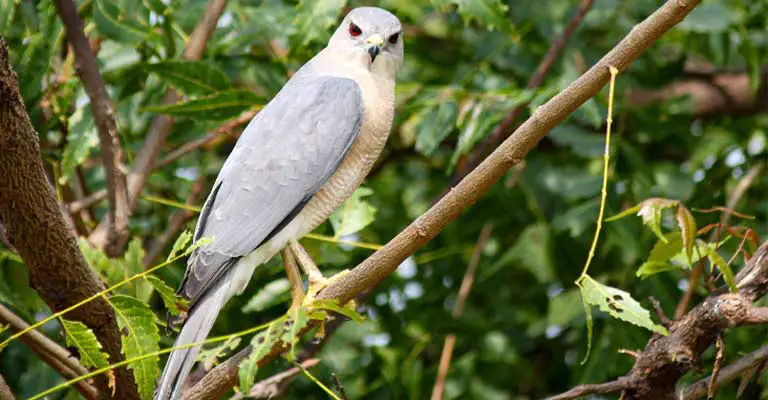
Identifying Characteristics of Shikra
The Shikra, scientifically known as Accipiter badius, is a small to medium-sized bird of prey that belongs to the Accipitridae family.
Identifying the Shikra requires a keen eye and attention to specific characteristics. Here are some key points to help distinguish this fascinating raptor:
Size and Shape
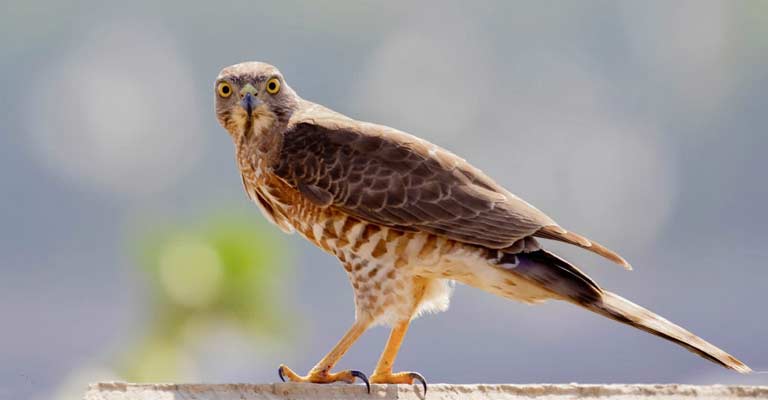
The Shikra is a compact bird with a length ranging from 25 to 30 cm. Its wings are short and rounded, and the tail is long, square-tipped, and often appears striped.
The overall body structure is stocky, contributing to its agile and swift flight.
Coloration
Adult Shikras display a striking combination of colors. The upperparts are usually a slate-grey or bluish-grey, while the underparts are finely barred in a warm rufous or chestnut color.
The distinctive color contrast aids in identification, especially during flight or while perched.
Head and Facial Features
The Shikra features a distinctive facial mask, characterized by a pale, almost white, supercilium (eyebrow stripe) and a dark line running through the eye.
This facial pattern contributes to a fierce and intense expression. The cere, the soft skin around the base of the beak, is yellow in color.
Eyes
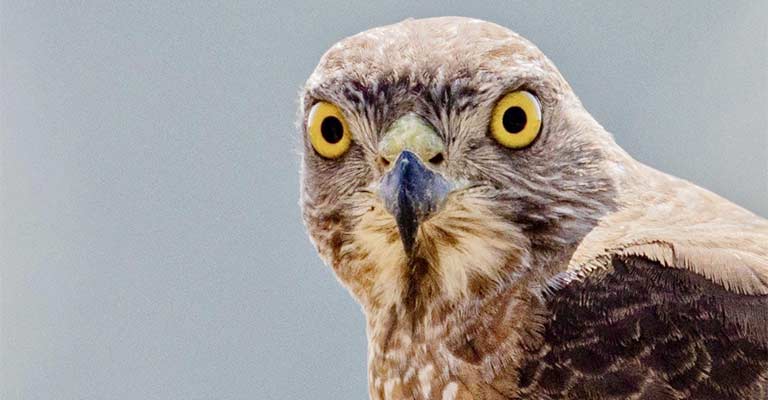
Shikras have large, bright yellow eyes that contribute to their keen vision. The eye color, combined with the facial features, adds to the bird’s overall striking appearance.
Bill and Talons
The hooked beak of the Shikra is sharp and well-adapted for tearing flesh, indicative of its carnivorous nature.
The talons are strong and curved, ideal for catching and grasping prey, further underlining its role as a bird of prey.
Flight Pattern
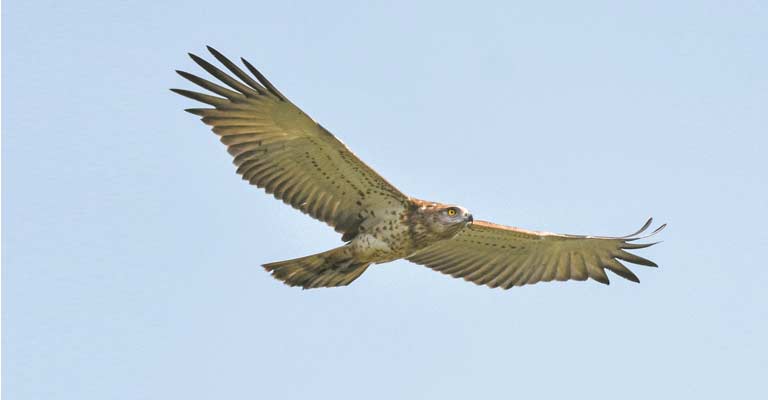
Shikras are known for their agile and acrobatic flight. Their short wings and long tail allow for quick maneuvers, making them skilled hunters.
During flight, their distinct coloration and barred underparts are often visible.
Habitat and Range
Understanding the habitat and range is crucial for identification. Shikras are commonly found in a variety of wooded habitats, including forests, woodlands, and even urban areas.
Their range spans across parts of Asia, from the Indian subcontinent to Southeast Asia.
Call and Vocalization

The Shikra has a distinctive, high-pitched, repetitive call that is often described as a series of sharp “ki-ki-ki” sounds.
Familiarizing oneself with this vocalization aids in auditory identification, especially when visual cues may be limited.
Identifying the Shikra involves a comprehensive understanding of its size, coloration, facial features, eyes, bill, talons, flight pattern, habitat, range, and vocalization.
Combining these key points will enhance one’s ability to recognize this captivating bird of prey in various settings, whether perched high in a tree or soaring gracefully through the skies.
Taxonomy of Shikra
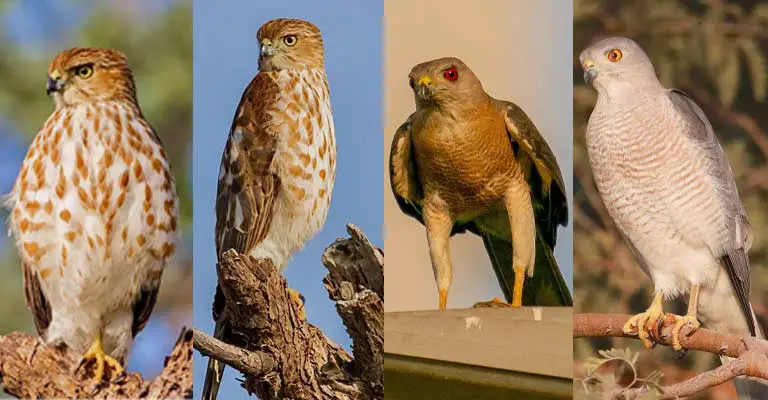
Here are the Taxonomy details of this bird;
| Taxonomic Category | Classification |
| Domain | Eukaryota |
| Kingdom | Animalia |
| Phylum | Chordata |
| Class | Aves |
| Order | Accipitriformes |
| Family | Accipitridae |
| Genus | Accipiter |
| Species | A. badius |
The Shikra (Accipiter badius) belongs to the domain Eukaryota, the kingdom Animalia, the phylum Chordata, and the class Aves. It is categorized under the order Accipitriformes and the family Accipitridae.
The genus of the Shikra is Accipiter, and its specific species designation is A. badius.
This systematic classification provides a structured understanding of the Shikra’s place in the broader context of the animal kingdom.
The Shikra (Accipiter badius) exhibits six recognized subspecies, each with distinct geographic distributions.
From the Senegal and Gambia to southwest Arabia, across central Asia, and into South Africa, these subspecies reflect the diverse range and adaptation of the Shikra across different regions.
| Subspecies | Scientific Name | Distribution |
| A. b. sphenurus | Rüppell, 1836 | Senegal and Gambia to southwest Arabia, south to north Tanzania, and north DR Congo |
| A. b. polyzonoides | Smith, A, 1838 | South DR Congo and south Tanzania to South Africa |
| A. b. cenchroides | Severtsov, 1873 | Caucasus to central Asia and northwest India |
| A. b. dussumieri | Temminck, 1824 | Central India and Bangladesh |
| A. b. poliopsis | Hume, 1874 | North India to South China, Indochina, and north Sumatra |
| A. b. badius | Gmelin, JF, 1788 | Southwest India and Sri Lanka |
Understanding the variations among these subspecies contributes to a comprehensive comprehension of the Shikra’s evolutionary and ecological dynamics.
Shikra Life History
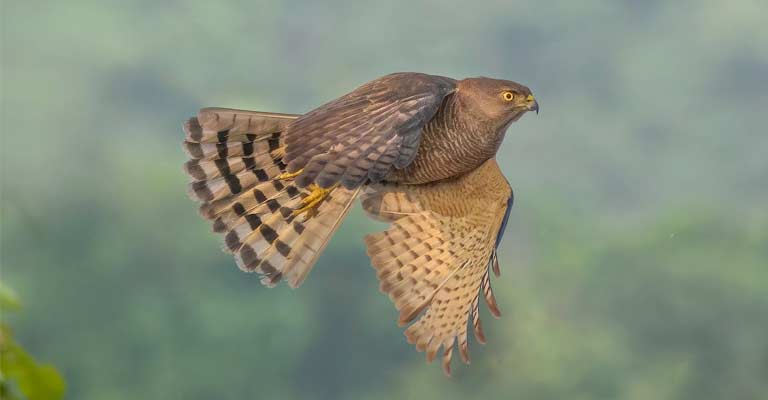
The Shikra (Accipiter badius), a fascinating bird of prey, boasts a rich and intricate life history that unfolds across various stages.
From its choice of food and habitat to its nesting behaviors, breeding strategies, and encounters with diseases, the Shikra’s life is a tapestry of survival and adaptation.
This comprehensive exploration delves into the different facets of the Shikra’s life, offering insights into its ecological niche and the challenges it faces in the wild.
Food
Shikras are carnivorous birds with a diverse diet that primarily consists of small birds, insects, and occasionally small mammals.
Known for their adept hunting skills, Shikras often employ stealth and surprise when capturing prey. Their sharp talons and hooked beaks are well-suited for tearing apart the flesh of their catch.
Habitat
Shikras display a remarkable adaptability to various habitats. They are commonly found in wooded areas, including deciduous and evergreen forests, as well as urban and suburban environments.
Their preference for diverse habitats allows them to thrive in a range of ecosystems, from dense woodlands to gardens and parks.
Range Map
The Shikra’s range spans a vast territory, extending from the Indian subcontinent across Southeast Asia.
A range map illustrates its distribution, showcasing its prevalence in countries like India, Bangladesh, Sri Lanka, Myanmar, Thailand, and parts of China.
Understanding the Shikra’s range is crucial for conservation efforts and habitat protection.
Nesting

Shikras exhibit meticulous nesting behaviors. They construct nests high in trees, typically using twigs, leaves, and other plant materials.
The female takes the lead in nest-building, while the male assists by providing materials. The elevated location of the nest offers protection from ground predators.
Nesting Details of Shikra (Accipiter badius)
| Nesting Aspect | Details |
| Clutch Size | Typically 3 to 5 eggs |
| Number of Broods | Usually 1 per breeding season |
| Egg Length | Approximately 35 to 45 mm |
| Egg Width | Approximately 28 to 35 mm |
| Incubation Period | Around 28 to 30 days |
| Nestling Period | Approximately 25 to 30 days |
| Egg Description | Pale bluish-white or greenish-white with light brown or reddish-brown spots. |
| Nesting Location | High in trees, often in the fork of branches |
| Nest Structure | Constructed using twigs, leaves, and other plant materials |
| Parental Roles | Both males and females share incubation and feeding responsibilities |
| Fledgling Stage | Young Shikras remain dependent on their parents for some time after fledging |
| Nest Protection | Elevated position protects from ground predators |
| Breeding Season | Varies geographically, often correlating with food availability |
| Courtship Displays | Include aerial acrobatics and mutual preening |
| Mating Behavior | Once a pair forms, they engage in copulation |
| Nest Reuse | Shikras may reuse nests in subsequent breeding seasons |
| Parental Care | Both parents are actively involved in caring for eggs and nestlings |
Understanding these nesting details is crucial for conservation efforts and promoting the well-being of Shikra populations.
Monitoring and protecting nesting sites, along with addressing factors that impact breeding success, contribute to the overall conservation of this fascinating bird of prey.
Breeding
Breeding season for Shikras varies geographically, often coinciding with the availability of food. Courtship displays involve aerial acrobatics, and once a pair forms a bond, they proceed to mate.
The female lays a clutch of eggs, and both parents share the responsibilities of incubation and feeding the chicks.
Diseases
Like many birds, Shikras can be susceptible to various diseases, including avian influenza and parasites.
Monitoring their health is essential for their survival. Human activities, such as habitat destruction and pollution, can contribute to the spread of diseases among Shikra populations.
Treatment
Conservation efforts include addressing threats to the Shikra population, both direct and indirect.
Mitigating habitat loss, controlling pollution, and monitoring the spread of diseases are vital components of treatment.
Captive breeding and rehabilitation programs also play a role in ensuring the species’ long-term survival.
Conservation
The Shikra faces conservation challenges due to habitat degradation, pesticide use, and illegal hunting.
Conservation initiatives focus on preserving their natural habitats, enforcing wildlife protection laws, and raising awareness about the importance of these raptors in maintaining ecological balance.
The life history of the Shikra is a compelling narrative of adaptation, survival strategies, and the delicate balance between human activities and wildlife conservation.
Understanding the intricacies of its food habits, nesting behaviors, breeding patterns, and conservation needs is crucial for fostering a harmonious coexistence between this remarkable bird of prey and its environment.
10 Fun Facts About Shikra
The Shikra, Accipiter badius, is a captivating bird of prey that inhabits a wide range across Asia. Here are 10 fun facts about this agile and stealthy raptor:
- Stealthy Hunter: Shikras are known for their exceptional hunting skills. With swift and silent flight, they can surprise their prey by swooping down from a concealed position.
- Urban Residents: Despite being birds of prey, Shikras display adaptability by thriving in urban and suburban environments. Gardens, parks, and even city outskirts are common locations for spotting these raptors.
- Distinctive Plumage: Adult Shikras boast a striking color contrast in their plumage. The bluish-grey upperparts paired with warm rufous or chestnut underparts make them visually distinctive.
- Masked Appearance: The facial features of Shikras contribute to their masked appearance. A pale supercilium and a dark line through the eye give them an intense and focused expression.
- Territorial Calls: Shikras communicate using a distinctive, high-pitched, repetitive call. These territorial calls are often heard during the breeding season as the birds establish and defend their territories.
- Migratory Behavior: Some Shikra populations exhibit migratory behavior, traveling considerable distances in response to changing seasons and food availability.
- Nest Builders: Shikras are skilled nest builders, constructing their nests high in trees using twigs, leaves, and other plant materials. The elevated position protects from ground predators.
- Parental Cooperation: During the breeding season, both male and female Shikras actively participate in incubating the eggs and caring for the nestlings. This cooperative parental behavior contributes to the success of their breeding endeavors.
- Versatile Diet: Shikras have a diverse diet that includes small birds, insects, and occasionally small mammals. Their adaptability allows them to switch prey depending on availability.
- Cultural Significance: In some cultures, the Shikra is associated with symbolism and mythology. Its presence in literature and art often reflects its role as a powerful and agile bird in various traditions.
The Shikra’s fascinating attributes extend beyond its role as a predator.
From its adaptability to urban life to its distinctive plumage and cooperative parenting, these fun facts contribute to the allure and charm of the Shikra in the avian world.
Wrapping Up
The Shikra, with its striking plumage, agile hunting prowess, and adaptable nature, stands as a captivating bird of prey.
From urban landscapes to dense woodlands, this raptor’s life history, nesting behaviors, and cultural significance add depth to our understanding of its place in the natural world.
Conservation efforts must continue to protect the Shikra’s habitats and ensure the coexistence of this remarkable species with human environments. Thank you for your time.